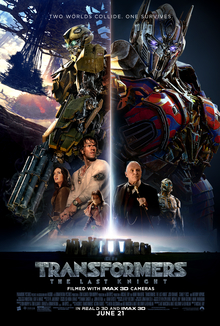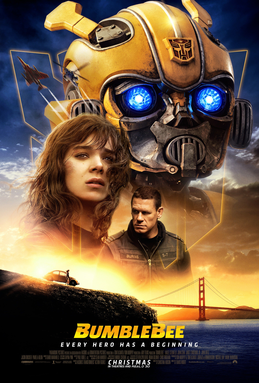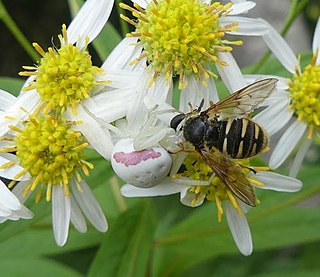| Bumblebee/Shining Eyes/1:30 | ||||
|---|---|---|---|---|
 | ||||
| EP by | ||||
| Released | 2001 | |||
| Genre | Indie rock | |||
| Label | Sit-n-Spin Records | |||
| The Comas chronology | ||||
| ||||
Bumblebee/Shining Eyes/1:30 is a 7" picture disc by North Carolina indie rock band The Comas.
| Bumblebee/Shining Eyes/1:30 | ||||
|---|---|---|---|---|
 | ||||
| EP by | ||||
| Released | 2001 | |||
| Genre | Indie rock | |||
| Label | Sit-n-Spin Records | |||
| The Comas chronology | ||||
| ||||
Bumblebee/Shining Eyes/1:30 is a 7" picture disc by North Carolina indie rock band The Comas.

Bees are winged insects closely related to wasps and ants, known for their roles in pollination and, in the case of the best-known bee species, the western honey bee, for producing honey. Bees are a monophyletic lineage within the superfamily Apoidea. They are currently considered a clade, called Anthophila. There are over 20,000 known species of bees in seven recognized biological families. Some species – including honey bees, bumblebees, and stingless bees – live socially in colonies while most species (>90%) – including mason bees, carpenter bees, leafcutter bees, and sweat bees – are solitary.

The Shining is a 1977 horror novel by American author Stephen King. It is King's third published novel and first hardcover bestseller; its success firmly established King as a preeminent author in the horror genre. The setting and characters are influenced by King's personal experiences, including both his visit to The Stanley Hotel in 1974 and his struggle with alcoholism. The novel was adapted into a 1980 film and a 1997 miniseries. The book was followed by a sequel, Doctor Sleep, published in 2013, which in turn was adapted into a film of the same name in 2019.

A bumblebee is any of over 250 species in the genus Bombus, part of Apidae, one of the bee families. This genus is the only extant group in the tribe Bombini, though a few extinct related genera are known from fossils. They are found primarily in higher altitudes or latitudes in the Northern Hemisphere, although they are also found in South America, where a few lowland tropical species have been identified. European bumblebees have also been introduced to New Zealand and Tasmania. Female bumblebees can sting repeatedly, but generally ignore humans and other animals.

A cat's eye or road stud is a retroreflective safety device used in road marking and was the first of a range of raised pavement markers.
"Flight of the Bumblebee" is an orchestral interlude written by Nikolai Rimsky-Korsakov (1844–1908) for his opera The Tale of Tsar Saltan, composed in 1899–1900. Its composition is intended to musically evoke the seemingly chaotic and rapidly changing flying pattern of a bumblebee. Despite the piece being a rather incidental part of the opera, it is today one of the more familiar classical works because of its frequent use in popular culture.

The Shining is a 1980 psychological horror film produced and directed by Stanley Kubrick and co-written with novelist Diane Johnson. It is based on Stephen King's 1977 novel of the same name and stars Jack Nicholson, Danny Lloyd, Shelley Duvall, and Scatman Crothers. Nicholson plays Jack Torrance, a writer and recovering alcoholic who accepts a new position as the off-season caretaker of the Overlook Hotel. Lloyd plays his young son Danny, who has psychic abilities, which he learns about from head chef Dick Hallorann (Crothers). Danny's imaginary friend Tony warns him the hotel is haunted before a winter storm leaves the family snowbound in the Colorado Rockies. Jack's sanity deteriorates under the influence of the hotel and the residents, and Danny and his mother Wendy (Duvall) face mortal danger.

Once in a LIVEtime is the second live album by American progressive metal band Dream Theater, released in 1998. It is their second live release. It was produced and recorded by Kevin Shirley during the European leg of the Touring into Infinity world tour, at the Bataclan theater in Paris.

Bumblebee is a superheroine appearing in American comic books published by DC Comics and other related media, commonly as a member of the Teen Titans. She first appeared as Karen in December 1976's Teen Titans #45, and adopted the Bumblebee identity three issues later. Historically, Bumblebee is sometimes considered DC Comics' first Black woman superhero character, though this distinction is also accorded to Nubia, a less traditional costumed crimefighter than Bumblebee, who debuted three years earlier in 1973.

Bumblebee is a fictional robot character appearing in the many continuities in the Transformers franchise. The character is a member of the Autobots, a group of sentient, self-configuring, modular extraterrestrial robotic lifeforms.
Transformers is a series of science fiction action films based on the Transformers franchise. Michael Bay directed the first five live action films: Transformers (2007), Revenge of the Fallen (2009), Dark of the Moon (2011), Age of Extinction (2014), and The Last Knight (2017), and has served as a producer for subsequent films. A sixth film Bumblebee, directed by Travis Knight, was released in 2018, while a seventh film, Rise of the Beasts, directed by Steven Caple Jr. was released in 2023.

Transformers: The Last Knight is a 2017 American science fiction action film based on Hasbro's Transformers toy line. It is the sequel to Transformers: Age of Extinction (2014) and the fifth installment in the Transformers film series. The film is directed by Michael Bay from a screenplay by Art Marcum, Matt Holloway, and Ken Nolan. It stars Mark Wahlberg reprising his role from Age of Extinction, while Josh Duhamel reprises his role from the first three films, and Stanley Tucci and Anthony Hopkins join the cast. Inventor Cade Yeager is gifted a Talisman by a dying Transformer knight, and is soon recruited by an eccentric British professor to save the world from the impending threat of Unicron.

Bumblebee is a 2018 science fiction action film based on the Hasbro and Takara Tomy's Transformers toy line character of the same name. It is the sixth installment in the Transformers film series, serving as a spin-off and prequel to the 2007 film. The film is directed by Travis Knight and written by Christina Hodson. It stars Hailee Steinfeld, John Cena, Jorge Lendeborg Jr., John Ortiz, Jason Drucker, and Pamela Adlon, and features Dylan O'Brien, Angela Bassett, Justin Theroux, and Peter Cullen in voice roles. It was Knight's first live-action film, as well as the first film in the Transformers series not to be directed by Michael Bay, who instead acted as a producer. Principal photography on the film began on July 31, 2017, in Los Angeles and San Francisco, California. Set in 1987, Autobot Bumblebee is sent to Earth but is injured and is found and helped by a teenage girl named Charlie.
Transformers: Cyberverse is a cel shaded computer-animated series based on the Transformers toy franchise by Hasbro. The series debuted on Cartoon Network on August 27, 2018.

"Night-Shining White" is a monochrome ink-on-paper painting by the Chinese artist Han Gan. It is an example of Tang dynasty painting, created in the middle of the 8th century. The work depicts a cavalry horse owned by the Emperor Xuanzong of the Tang dynasty, tethered to a post. It is considered one of the greatest equine portraits in Chinese painting. It was acquired by the Metropolitan Museum in 1977.

Eristalis flavipes, the orange-legged drone fly, is a species of hoverfly native to North America. It flies from early April to mid-October, and occurs in a wide variety of habitats, particularly wetlands. Hoverflies get their names from the ability to remain nearly motionless while in flight. The adults are also known as flower flies for they are commonly found around and on flowers, from which they get both energy-giving nectar and protein-rich pollen. The larvae are aquatic filter-feeders of the rat-tailed type.

Eristalis anthophorina, the orange-spotted drone fly, is a species of syrphid fly with a Holarctic distribution. It is a common fly in wetlands, including bogs, fens, and woodland pools. In North America, it occurs throughout much of Canada and primarily in the northern parts of the United States. It may be introduced in North America.

Sericomyia bifasciata, the Long-nosed Pond Fly, is an uncommon species of syrphid fly. They have been observed from the northeastern part of North America. Hoverflies get their names from the ability to remain nearly motionless while in flight. The adults are also known as flower flies for they are commonly found around and on flowers, from which they get both energy-giving nectar and protein-rich pollen. The larvae in the genus Sericomyia are known as the rat-tailed with a long breathing tube taylored for aquatic environments. The larvae for this species are unknown.

Shining Girls is an American thriller television series based on the 2013 novel The Shining Girls by Lauren Beukes. The series stars Elisabeth Moss, Wagner Moura and Jamie Bell. It premiered on Apple TV+ on April 29, 2022. A portion of the series premiered at South by Southwest on March 11, 2022.

Bombus morawitzi is a bumblebee species in the subgenus Sibiriocobombus endemic to Central Asia, particularly mountainous regions of Afghanistan, China, Kazakhstan, Kyrgyzstan, and Tajikistan.